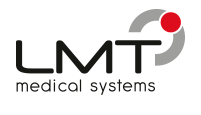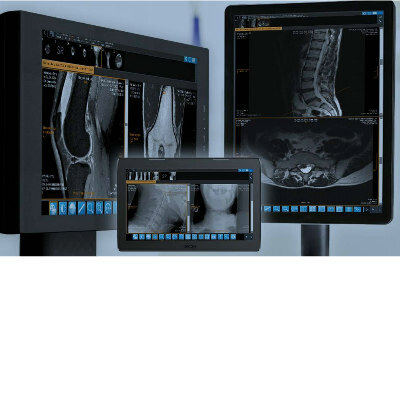Advanced Visualization Table Features Capacitive Touch Interface
|
By MedImaging International staff writers Posted on 21 Dec 2015 |
An enhanced 55-inch visualization table with state-of-the-art touch technology enables medical staff to smoothly navigate three dimensional (3D) images of actual patient cases.
The next-generation Sectra (Linköping, Sweden) F15 visualization table with capacitive touch technology allows medical staff and students to gain enhanced understanding of the body’s anatomy and functions, the variation between individuals, and visually explore more unusual diseases. The 3D images are taken by modern computed tomography (CT) and magnetic resonance imaging (MRI) cameras. Users of the table can simply zoom in, rotate, or cut into the visualized body without using a scalpel, and can repeat virtual autopsies and dissections over and over.
The table also serves as a terminal for the proprietary Sectra Education Portal, a concept for sharing patient cases and teaching content and knowledge with other universities that use the Sectra Table. Based on an enterprise image management platform, the tables is suitable for all training programs, including anatomy training on virtual images of actual patient cases from other universities, in addition to the preinstalled training images that accompany the table.
“The visualization table allows us to modernize and increase the quality of our teaching,” said Sandra Ceccatelli, MD, PhD, head of the department of neuroscience and in charge of anatomy teaching at the Karolinska Institutet (Solna, Sweden). “The table opens up unique opportunities to convey basic knowledge about the body, offering a whole new way to teach anatomy to our students.”
The visualization table was developed in cooperation between the Linköping University (Sweden) Center for Medical Image Science and Visualization (CMIV), Visualiseringscenter C (Norrköping, Sweden),and The Interactive Institute (TII; Stockholm, Sweden).
Related Links:
Sectra
Linköping University
Visualiseringscenter C
The next-generation Sectra (Linköping, Sweden) F15 visualization table with capacitive touch technology allows medical staff and students to gain enhanced understanding of the body’s anatomy and functions, the variation between individuals, and visually explore more unusual diseases. The 3D images are taken by modern computed tomography (CT) and magnetic resonance imaging (MRI) cameras. Users of the table can simply zoom in, rotate, or cut into the visualized body without using a scalpel, and can repeat virtual autopsies and dissections over and over.
The table also serves as a terminal for the proprietary Sectra Education Portal, a concept for sharing patient cases and teaching content and knowledge with other universities that use the Sectra Table. Based on an enterprise image management platform, the tables is suitable for all training programs, including anatomy training on virtual images of actual patient cases from other universities, in addition to the preinstalled training images that accompany the table.
“The visualization table allows us to modernize and increase the quality of our teaching,” said Sandra Ceccatelli, MD, PhD, head of the department of neuroscience and in charge of anatomy teaching at the Karolinska Institutet (Solna, Sweden). “The table opens up unique opportunities to convey basic knowledge about the body, offering a whole new way to teach anatomy to our students.”
The visualization table was developed in cooperation between the Linköping University (Sweden) Center for Medical Image Science and Visualization (CMIV), Visualiseringscenter C (Norrköping, Sweden),and The Interactive Institute (TII; Stockholm, Sweden).
Related Links:
Sectra
Linköping University
Visualiseringscenter C
Read the full article by registering today, it's FREE! 

Register now for FREE to MedImaging.net and get access to news and events that shape the world of Radiology. 
- Free digital version edition of Medical Imaging International sent by email on regular basis
- Free print version of Medical Imaging International magazine (available only outside USA and Canada).
- Free and unlimited access to back issues of Medical Imaging International in digital format
- Free Medical Imaging International Newsletter sent every week containing the latest news
- Free breaking news sent via email
- Free access to Events Calendar
- Free access to LinkXpress new product services
- REGISTRATION IS FREE AND EASY!
Sign in: Registered website members
Sign in: Registered magazine subscribers
Latest Imaging IT News
- New Google Cloud Medical Imaging Suite Makes Imaging Healthcare Data More Accessible
- Global AI in Medical Diagnostics Market to Be Driven by Demand for Image Recognition in Radiology
- AI-Based Mammography Triage Software Helps Dramatically Improve Interpretation Process
- Artificial Intelligence (AI) Program Accurately Predicts Lung Cancer Risk from CT Images
- Image Management Platform Streamlines Treatment Plans
- AI-Based Technology for Ultrasound Image Analysis Receives FDA Approval
- AI Technology for Detecting Breast Cancer Receives CE Mark Approval
- Digital Pathology Software Improves Workflow Efficiency
- Patient-Centric Portal Facilitates Direct Imaging Access
- New Workstation Supports Customer-Driven Imaging Workflow
Channels
Radiography
view channel
Novel Breast Imaging System Proves As Effective As Mammography
Breast cancer remains the most frequently diagnosed cancer among women. It is projected that one in eight women will be diagnosed with breast cancer during her lifetime, and one in 42 women who turn 50... Read more
AI Assistance Improves Breast-Cancer Screening by Reducing False Positives
Radiologists typically detect one case of cancer for every 200 mammograms reviewed. However, these evaluations often result in false positives, leading to unnecessary patient recalls for additional testing,... Read moreMRI
view channel
PET/MRI Improves Diagnostic Accuracy for Prostate Cancer Patients
The Prostate Imaging Reporting and Data System (PI-RADS) is a five-point scale to assess potential prostate cancer in MR images. PI-RADS category 3 which offers an unclear suggestion of clinically significant... Read more
Next Generation MR-Guided Focused Ultrasound Ushers In Future of Incisionless Neurosurgery
Essential tremor, often called familial, idiopathic, or benign tremor, leads to uncontrollable shaking that significantly affects a person’s life. When traditional medications do not alleviate symptoms,... Read more
Two-Part MRI Scan Detects Prostate Cancer More Quickly without Compromising Diagnostic Quality
Prostate cancer ranks as the most prevalent cancer among men. Over the last decade, the introduction of MRI scans has significantly transformed the diagnosis process, marking the most substantial advancement... Read moreUltrasound
view channel
Deep Learning Advances Super-Resolution Ultrasound Imaging
Ultrasound localization microscopy (ULM) is an advanced imaging technique that offers high-resolution visualization of microvascular structures. It employs microbubbles, FDA-approved contrast agents, injected... Read more
Novel Ultrasound-Launched Targeted Nanoparticle Eliminates Biofilm and Bacterial Infection
Biofilms, formed by bacteria aggregating into dense communities for protection against harsh environmental conditions, are a significant contributor to various infectious diseases. Biofilms frequently... Read moreNuclear Medicine
view channel
New SPECT/CT Technique Could Change Imaging Practices and Increase Patient Access
The development of lead-212 (212Pb)-PSMA–based targeted alpha therapy (TAT) is garnering significant interest in treating patients with metastatic castration-resistant prostate cancer. The imaging of 212Pb,... Read moreNew Radiotheranostic System Detects and Treats Ovarian Cancer Noninvasively
Ovarian cancer is the most lethal gynecological cancer, with less than a 30% five-year survival rate for those diagnosed in late stages. Despite surgery and platinum-based chemotherapy being the standard... Read more
AI System Automatically and Reliably Detects Cardiac Amyloidosis Using Scintigraphy Imaging
Cardiac amyloidosis, a condition characterized by the buildup of abnormal protein deposits (amyloids) in the heart muscle, severely affects heart function and can lead to heart failure or death without... Read moreGeneral/Advanced Imaging
view channel
New AI Method Captures Uncertainty in Medical Images
In the field of biomedicine, segmentation is the process of annotating pixels from an important structure in medical images, such as organs or cells. Artificial Intelligence (AI) models are utilized to... Read more.jpg)
CT Coronary Angiography Reduces Need for Invasive Tests to Diagnose Coronary Artery Disease
Coronary artery disease (CAD), one of the leading causes of death worldwide, involves the narrowing of coronary arteries due to atherosclerosis, resulting in insufficient blood flow to the heart muscle.... Read more
Novel Blood Test Could Reduce Need for PET Imaging of Patients with Alzheimer’s
Alzheimer's disease (AD), a condition marked by cognitive decline and the presence of beta-amyloid (Aβ) plaques and neurofibrillary tangles in the brain, poses diagnostic challenges. Amyloid positron emission... Read more.jpg)
CT-Based Deep Learning Algorithm Accurately Differentiates Benign From Malignant Vertebral Fractures
The rise in the aging population is expected to result in a corresponding increase in the prevalence of vertebral fractures which can cause back pain or neurologic compromise, leading to impaired function... Read moreIndustry News
view channel
Bayer and Google Partner on New AI Product for Radiologists
Medical imaging data comprises around 90% of all healthcare data, and it is a highly complex and rich clinical data modality and serves as a vital tool for diagnosing patients. Each year, billions of medical... Read more





















